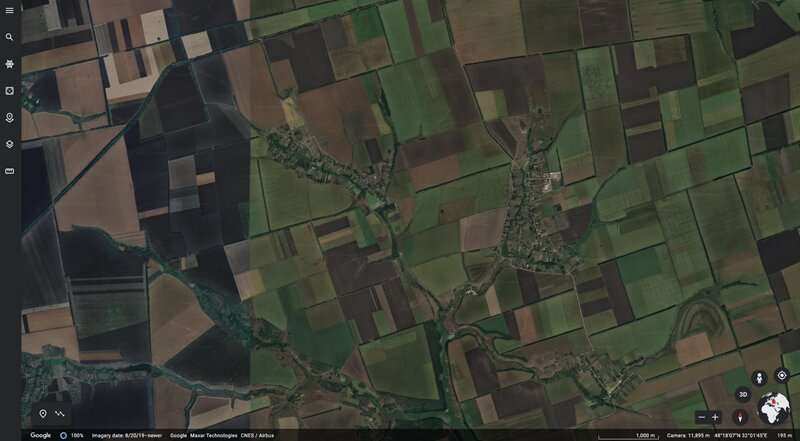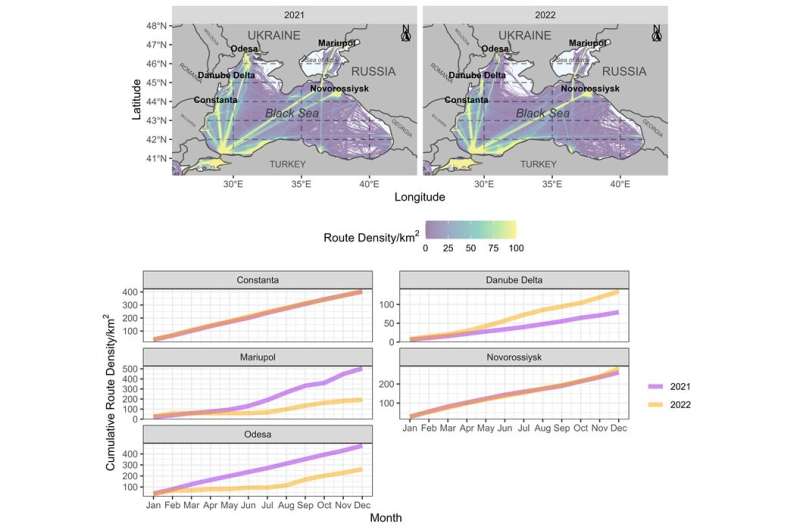This article has been reviewed according to Science X's editorial process and policies. Editors have highlighted the following attributes while ensuring the content's credibility:
fact-checked
peer-reviewed publication
trusted source
proofread
From fields to front lines: The impact of the war in Ukraine on global food supply

One country produces about 12% of the grains (wheat, barley, maize and sunflower) traded globally. Developing countries in Africa and South Asia rely heavily on it. In fact, this country supplies up to 40% of the grain distributed by the United Nation's World Food Program.
This country is Ukraine, and it is at war.
It's a case study of how disruptions to agriculture supply chains by events such as war, drought or pandemics can have wide-ranging and complex impacts. In a globalized and increasingly interconnected world, understanding the flow-on effects of these major events is crucial.
Our researchers analyzed images of Ukrainian cropland and cargo shipping activity after the Russian invasion taken by satellites.
Their work, published in the open access journal PLOS ONE, uses statistical modeling techniques to compare cropping and supply patterns in 2022 with historical data.
The results help pinpoint the impact of war on the global food supply.
Statistical modeling from space
Statistical modeling is a method that allows us to understand how and why variables change over time and space.
It's particularly useful for making predictions and understanding impacts when access to data is limited, such as during a war.
This research is the first to apply this method to satellite imagery during a conflict. It offers fast, remote insight into unfolding events.
Dr. Petra Kuhnert is an author and applied statistician from our Data61 business unit. She said these insights are fertile ground for decision-makers.
"This approach can be applied to a diverse range of events that disrupt food security, including pandemics, natural disasters, and economic downturns," Petra said.
"Governments and international agencies often need to take immediate action and respond to food value chain disruptions quickly. Such insights delivered at speed can prove incredibly valuable."
Michael Wellington is a Ph.D. student at the Australian National University. He is supervised by Petra and Roger Lawes, CSIRO researchers and co-authors of the modeling on Ukraine. Michael previously used this method to measure the impact of drought on crop production in Madagascar.
The island nation has been experiencing acute food shortages since early 2021. He found the method could be adapted for diverse farming systems from smallholder irrigation schemes to broadacre grain regions.

Export logistics disruption
A decade of crop growth and loss data, and two years of grain cargo shipping movements around Ukraine, was analyzed to create a baseline for comparison. The 2022 data was pulled from the Google Earth Engine and the European Marine Observation and Data Network.
The modeling showed Ukraine's 2022 overall crop productivity significantly decreased as a result of the war, compared to baseline data from 2010–2021.
Furthermore, the impact of the war on export logistics was severe.
A comparison of the density of cargo ship routes between 2021 and 2022 revealed activity around the Ukrainian ports at Odesa and Mariupol decreased by 45 and 62% respectively following the invasion.
Petra said these insights shed light on the importance of exploring multiple lines of evidence to understand the bigger picture when studying and responding to crises.
"Previous studies on the impacts of conflict on food systems have focused on farm production. However, our results suggest disruption to supply and logistics may be a greater threat," she said.
"This could be due to over-reliance on logistics facilities in a few key locations, while the many enterprises comprising the farm sector are geographically dispersed."
An early warning system for global food security
This work demonstrates rapid insights can be gained from satellite data during global challenges to inform international responses.
Co-author Dr. Roger Lawes is a farming systems scientist in our Agriculture and Food business unit. He said the method could be applied on a wider scale to act as an early warning system for global food security.
"This combination of farming systems research with big data analytics has created a new way to rapidly monitor the global food supply," Roger said.
"Quantifying the global impact of an ongoing event less than a month after it began could help manage acute food shortages.
"This method could help enhance the preparedness and resilience of the world's food system in the face of changing environmental, geopolitical and economic circumstances."
More information: Michael Wellington et al, Rapid monitoring of cropland primary productivity and shipping activity in Ukraine, PLOS ONE (2023). DOI: 10.1371/journal.pone.0286637
Journal information: PLoS ONE
Provided by CSIRO



















